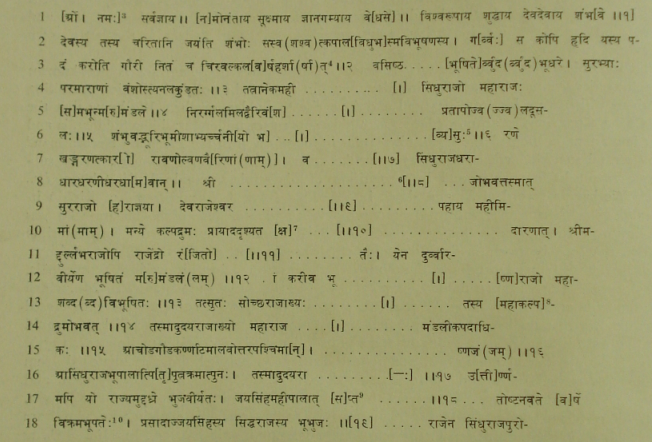| |
North
Indian Inscriptions |
| |
|
|
|
INSCRIPTIONS OF THE PARAMARAS OF BHINMAL
to be identified. Sindhurājapura mentioned in v. 20 cannot be identified for want of any evidence; and Kirāṭakūpa (v. 22) is the same place now known as Kirāḍū where the inscribed stone was found and which appears to have been derived from it. Śivakūpa (?) may have been any place in the vicinity of Kirāḍū, but I am unable to suggest its identification. Taṇukōṭṭa and
Navasara (v.25) are the forts now known Tanōṭ and Nausar, respectively in the regions of
Jaisalmēr and Jodhpur, as already identified by G.V. Acharya.
[1]
TEXT
[2]
[Metres : Verses 1 and 3-27 Anushṭubh ; v. 2 Vasantatilaka].

______________________
The first of these places is on the northern border of the Jaisalmēr District and about 25 kms. from Rāmgaḍh, the chief town of a tehsīl ; and the second, now known as Nōnsar, is about 20 kms. from Osian, the principal town of a tehsīl in the Jodhpur District of Rājasthān.
From impressions.
[3] A portion of the slab has peeled off and the bracketed letters which are now missing are supplied from Acharya’s reading.
[4] The eleventh and the thirteenth of the aksharas of the fourth foot of this verse are damaged ; and whereas Acharya read the last word as हर्शा(र्षा)त्, Nahar read it as दर्शात् ; but the sense of the latter half of this verse is not intelligible to me. The second letter of the latter half of this verse is equally damaged.
[5] The bracketed letter has left only traces and hence the reading is not certain.
[6] The name of Dharaṇīvarāha, found in the Vasantagaḍh inscription, appears to have been lost here in v. 7 or 8. The first hemistich of this verse mentions a king and compares him with Dharaṇīdhara, i.e.,Varāha, “and just as the latter supported the dharā (Earth ) immersed in Sindhurāja (the ocean), so Vol. XL, p. 239.
[7] This akshara is as read by Acharya, but the metre would not require a conjunct consonant here. In the impressions it has totally disappeared and the preceding letter is also partly visible.
[8] Only traces of the bracketed letters are visible and they are supplied from Acharya’s reading.
[9] The two aksharas with the number of the verse are restored from Acharya’s reading. The following three aksharas नबाते are damaged.
[10] The mātrā of this akshara is engraved as if mingled with the vertical of the preceding one.
CORPUS INSCRIPTIONUM INDICARUM
VOL.VII PLATE XC
..............KIRADU STONE INSCRIPTION OF SOMESVARA: (VIKRAMA) YEAR 1218

|
\D7
![]()
|









